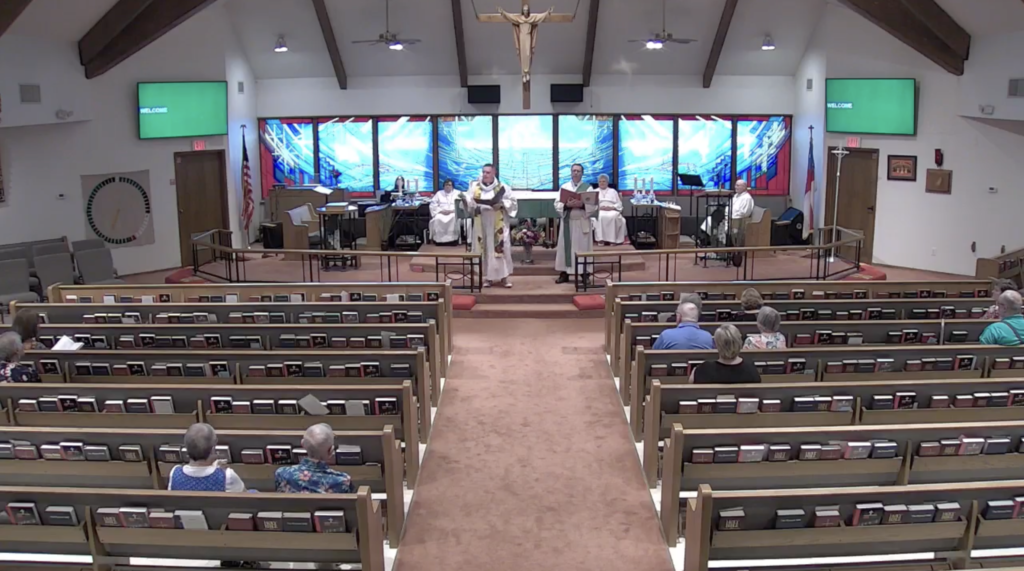
It’s not a surprise to anyone that the Church is changing. Some say the Church is dying, but I prefer to be a little more positive than that. If we’re honest with ourselves, then we’ll acknowledge that the Church has been changing and evolving for 2000 years. Perhaps it has been easier to navigate change in the past than it is now, but there have always been changes. If you want to see some examples for yourself, do an online search for the evolution of baptismal fonts. The size, shape, and even location of fonts within the building, have changed repeatedly over 2000 years. Clerical vestments have evolved. Look at what an Eastern Rite priest wears compared to a Western Rite priest (And look at what many other Episcopal priests wear compared to what Fr. Tim wears!). The pandemic sped up some of the change that likely would have happened anyway, albeit at a much slower pace. Clergy have retired in greater numbers, fewer postulants have entered seminary, and some people got out of the habit of attending church every week and have simply decided to not return. Expressions of Church have hurt people over the years and some people believe in Jesus but do not wish to attend a church because they are fearful of being wounded yet again. Some people refrain from attending church because their experiences of church have demonstrated misogyny, racism, transphobia, homophobia, and even hypocrisy. Although a welcoming and affirming church like St. John’s can go a long way to help people to heal and to grow the kingdom of God, wounded people are understandably skeptical of any church. They simply do not want to be hurt again. That’s why our mission is more important now than ever before. We must find innovative and successful ways to grow the Church and to share the love and joy that we already experience.
Think back to two years ago. St. John’s was in a period of discernment to decide who to call as the new Rector. Part of the parish discernment process is to write something called a parish profile. And although each parish thinks its profile is unique, many profiles say something quite similar. I’ve read so many parish profiles that I could probably write one for every parish in the Episcopal Church. It would look something like this: “We are a welcoming and affirming parish and we value diversity. We seek a pastor who will help us to grow and especially to attract young families and children.” Every parish in the Episcopal Church claims publicly to be welcome and affirming to LGBTQ+ people, racially diverse, and desiring to grow. If we look around our parish, we understand that our population is aging. Although it’s unpleasant to think about it, the reality is that if we do not attract young families to St. John’s, attendance will drop over the next 20 years. Some parishioners will become home bound, and others will die. True, death is not a pleasant topic. But one day our earthly journeys will be complete. Although we want to be here for as long as possible, none of us is here forever.
Because every Episcopal parish is similar, many of us are doing the same things to try to attract younger members. But as Albert Einstein taught us, “the definition of insanity is doing the same thing over and over and expecting different results.” If the techniques employed at Episcopal parishes worked, then our parishes would be standing room only, our endowments would be plentiful, and we’d have an endless stream of postulants and seminarians. We’d even be able to cover the cost of seminary education for up-and-coming priests! What a world!
This is not a pipe dream. I believe it can be a reality. We simply need to do things differently. We need to acknowledge the changing world around us, and we need to adapt to a world that is different than the world in which we were raised. Technology is different, public opinion is different, and even music is different. People have excellent “bovine excrement” detectors, and they know when they’re being patronized. Authentic, genuine expressions of love, joy, and something called “radical welcome”, are needed to demonstrate that this church is a place of healing, hope, and comfort. Here at St. John’s, we can share the joy of Jesus to people from all walks of life. We just need to get the message out. But if what we’ve tried in the past doesn’t work, then how do we know what we want to try? We have to be creative.
I want you to look at the photo below. This photo was taken from a screenshot of one of our Sunday services right after the exchange of the peace. Look at it closely and pay attention to what you notice.

I notice what looks like an empty church. On a Sunday. At the principal Sunday service. Do you notice the same thing? The church was not empty that Sunday. There were people there. I attest to that. I was looking at them. But they’re not in the photo. Why not? Because Episcopalians tend to sit in the back. What I have for you is a big ask. I know it’s not a request that will make you very comfortable. But if we don’t get out of our comfort zones, we’ll never achieve our goals. We try things that are hard, not things that are easy! I want you to sit toward the front of the church. I want you to fill out the front few rows. I want people who are tuning in, investigating St. John’s, to see a full church. I want people to see a church community to which they want to belong. Aren’t you more likely to attend a church that looks full? Aren’t you more likely to attend a church where it looks like people are already attending? If I’m seeking infectious joy, I want to know the people there are already feeling it. If I see no people, I’m going to assume there isn’t any and I’ll look elsewhere. Perception is reality. If the church building looks empty, the assumption is that it is empty. This is true even when we have a sizable congregation. Please sit in view of the camera.
I also want us to be active on social media. This is where people younger than me hang out. This is how people younger than me communicate. This is how young people get their news and information. This is how they decide to try new restaurants and businesses. This is how they are entertained. Social media is where and how millennials and zoomers live their lives. Most of us here at St. John’s have Facebook accounts. Fewer of us have Instagram accounts. Fewer still have TikTok or Snapchat. We don’t need to be proficient in all of them, but we can use some of them to invite people to join us. Most Facebook users are in their 40s and older. Younger people use Instagram, TikTok, and Snapchat. I have created a St. John’s Instagram page and three videos. To date, these videos have been seen by more than 2000 sets of eyes in a one-week period. How do more eyes see them? Something called “like and share.” If St. John’s posts something, and you like it, it boosts the post’s popularity. If you comment, it boosts it even more. If you share it, then it boosts it even more. The “algorithm” wants to keep users logged in, so the most popular posts end up getting more exposure. The more it’s liked and shared, the more widely it is spread. So if St. John’s shares a post and each of its members like it and comment on it and share it, then 2000 quickly balloons to an exponentially higher number. And if thousands of people like what they see, and they realize they will find joy here, then maybe a few of them will stop in and join us.
I’m going to do some work over the next few weeks to help bring our parishioners up to speed on how to use social media. I’m going to host some seminars about how to create accounts and to maximize “online presence.” This is where the younger people reside. They want to see pictures and videos of fun, engaging worship. And they want to see a church that looks full. I have a philosophy when I’m traveling and looking for a restaurant: Always eat at the restaurant with the longest line. People vote with their feet and, their votes influence others. If there are butts in the pews, and those pews are visibly full, then it’s much more inviting and there’s a much greater chance we can influence bigger attendance numbers. Bigger attendance numbers means greater opportunities for stewardship and evangelism. It also means more people will experience the joy of Christ in the world. Marshall McLuhan, a Canadian philosopher who studied mass media, teaches us “the medium is the message.” In other words, if we demonstrate activity on media platforms, then that message will translate that we’re active in life. We are active in life, so let’s show the world how great St. John’s truly is!
